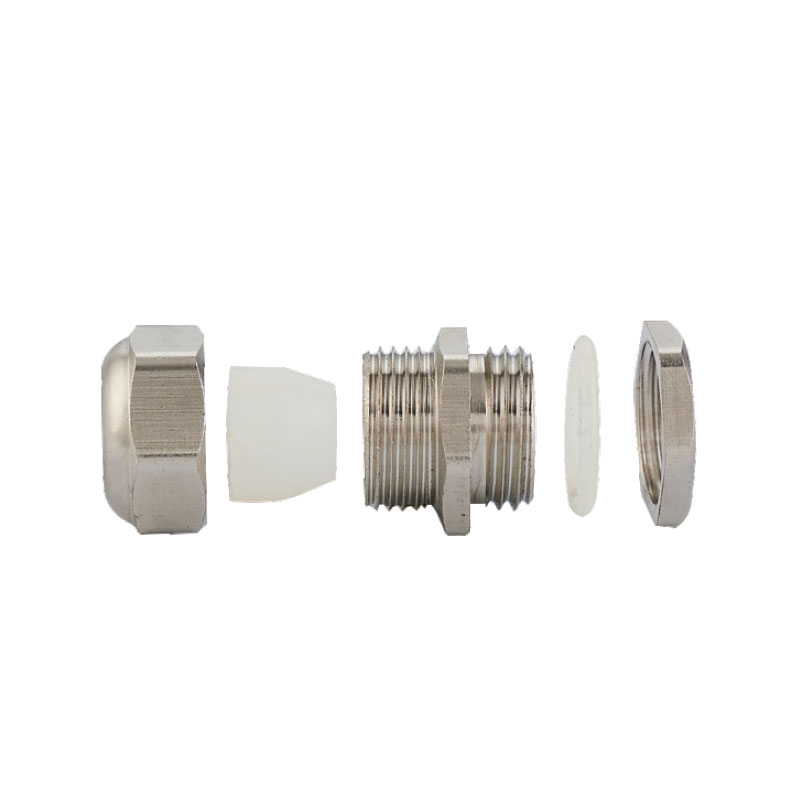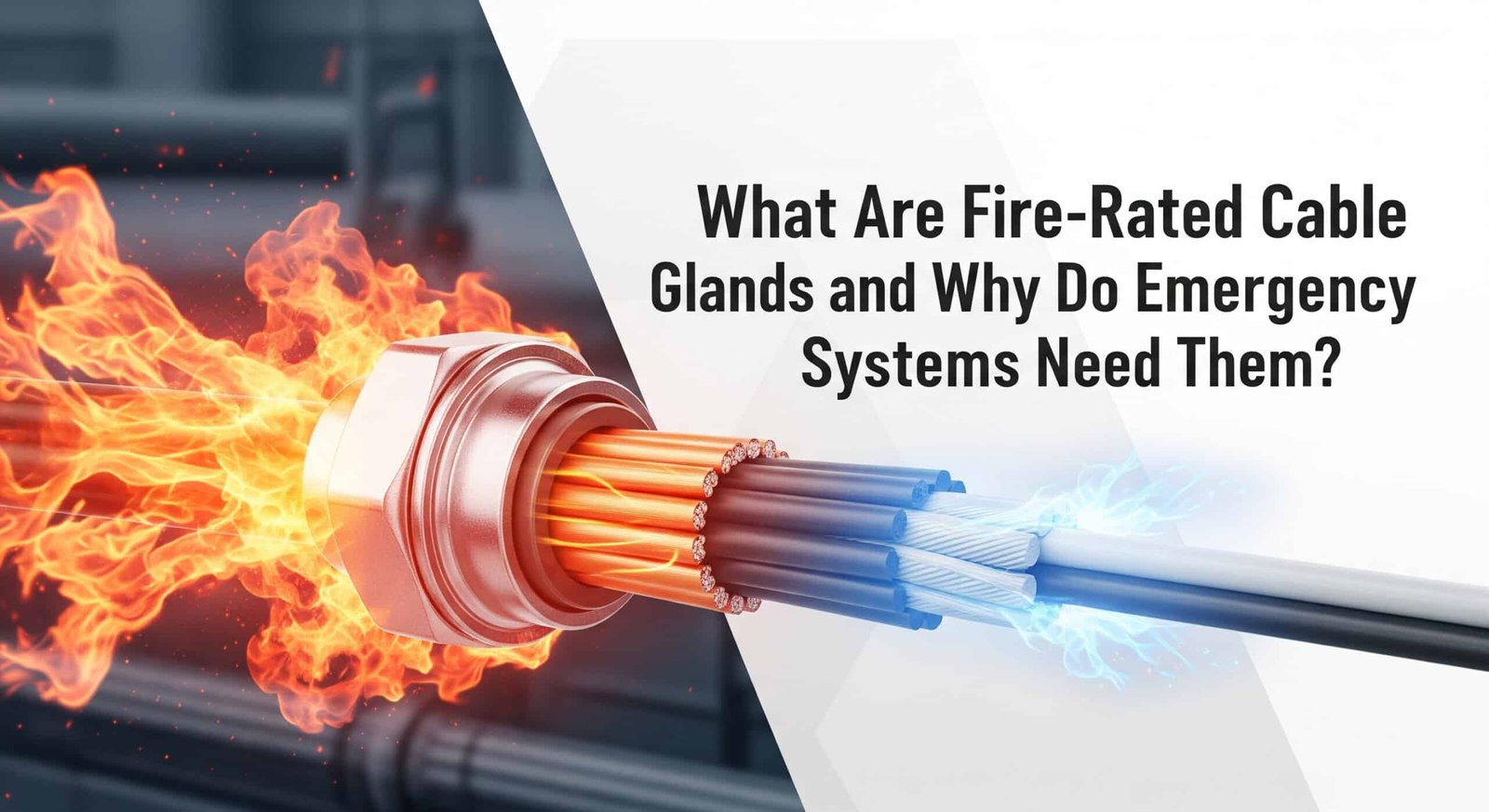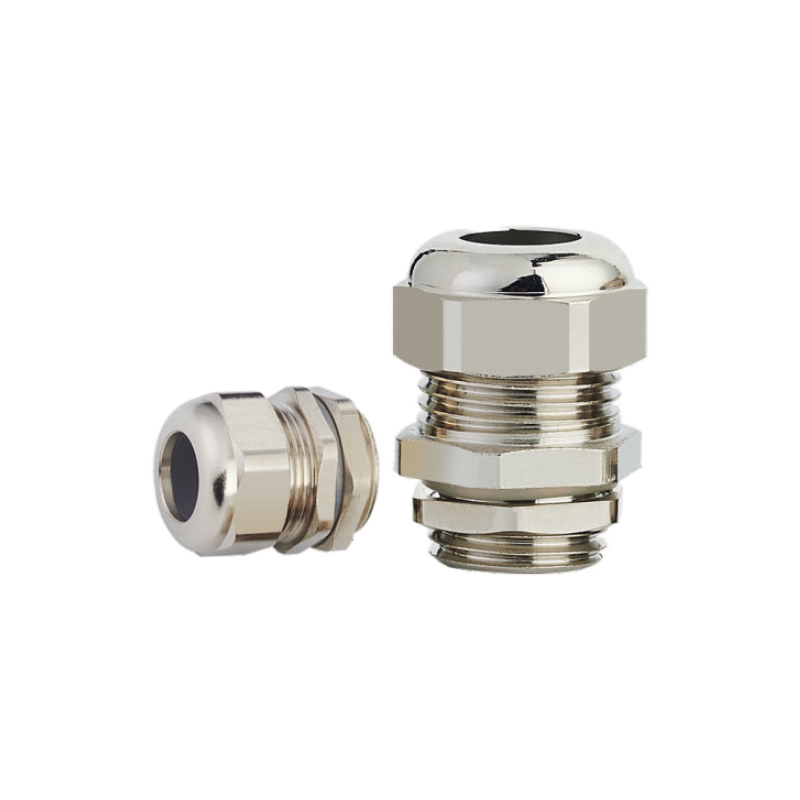Fel i nödsystem under bränder kostar liv och miljarder i egendomsskador varje år när standardkabelförskruvningar brister under extrem värme och bryter strömmen till kritisk säkerhetsutrustning som brandpumpar, nödbelysning och rökutsugningssystem inom några minuter efter brandexponering. Många fastighetsförvaltare underskattar vikten av brandklassade kabelanslutningar och antar att IP-klassade standardförskruvningar ger tillräckligt skydd, vilket leder till katastrofala fel i säkerhetssystemen när de behövs som mest.
Brandklassade kabelgenomföringar som uppfyller IEC 60331-standarderna bibehåller kretsintegritet1 i 90-180 minuter vid temperaturer upp till 750°C, vilket säkerställer att nödsystemen fortsätter att fungera under bränder genom att kabelanslutningarna skyddas med specialiserade brandbeständiga material, svällande tätningsmedel och värmebeständiga metallkonstruktioner som förhindrar att lågor tränger in och upprätthåller den elektriska kontinuiteten. Dessa specialiserade genomföringar är viktiga för livräddningssystem på sjukhus, flygplatser, i tunnlar och höghus.
Efter att ha arbetat med entreprenörer för nödsystem, brandsäkerhetsingenjörer och fastighetsägare i Europa, Nordamerika och Asien - från Londons tunnelbanestationer till Dubais internationella flygplats - har jag sett hur korrekt val av brandklassade kabelförskruvningar direkt påverkar livssäkerheten och efterlevnaden av regelverk. Låt mig dela med mig av den kritiska kunskap som alla säkerhetsexperter behöver för att skydda nödsystem.
Innehållsförteckning
- Vad skiljer brandklassade kabelförskruvningar från standardförskruvningar?
- Vilka brandklassningsstandarder gäller för kabelgenomföringar för nödsystem?
- Hur väljer du rätt brandklassad kabelförskruvning för din applikation?
- Vilka är installationskraven för brandklassade kabelförskruvningar?
- Hur upprätthåller du brandklassningen under systemets hela livslängd?
- Vanliga frågor om brandklassade kabelgenomföringar
Vad skiljer brandklassade kabelförskruvningar från standardförskruvningar?
Brandklassade kabelförskruvningar använder specialiserade brandbeständiga material, svällande tätningssystem och värmebeständig konstruktion som bibehåller kretsintegriteten och förhindrar flamgenomträngning under specificerade tidsperioder vid extrema temperaturer, medan standardförskruvningar går sönder inom några minuter efter brandexponering.
Det är viktigt att förstå dessa kritiska skillnader eftersom standardkabelförskruvningar som fungerar bra under normala förhållanden blir säkerhetsrisker vid brandtillbud.

Konstruktion av brandsäkert material
Värmebeständiga metaller: Brandklassade genomföringar använder speciallegeringar och värmebehandlade material som bibehåller strukturell integritet vid temperaturer över 750°C under längre perioder.
Intumescenta tätningssystem: Avancerade tätningsmaterial expanderar när de utsätts för värme och skapar en isolerande barriär som förhindrar att flammor och rök tränger in genom kabelgenomföringar.
Isolering med keramisk fiber: Högtemperaturisoleringsmaterial skyddar interna komponenter och upprätthåller elektrisk kontinuitet under brandexponering.
Brandbeständiga polymerer: Specialiserade plastkomponenter motstår förbränning och bibehåller mekaniska egenskaper vid förhöjda temperaturer till skillnad från standardmaterial i nylon eller PVC.
Prestanda för kretsintegritet
Elektrisk kontinuitet: Brandklassade genomföringar upprätthåller elektriska anslutningar under specificerade tidsperioder, vilket säkerställer att nödsystem fortsätter att fungera när de behövs som mest.
Isolationsmotstånd: Brandbeständiga material förhindrar elektriska fel och kortslutningar som kan slå ut nödsystem vid bränder.
Mekanisk stabilitet: Förskruvningskomponenterna motstår värmeutvidgning, skevhet och strukturella fel som kan äventyra kabelanslutningarna.
Flamskyddande barriärskydd: Specialiserad tätning förhindrar brandspridning genom kabelvägar och upprätthåller uppdelning i avdelningar2 avgörande för brandsäkerheten i byggnader.
Test- och certifieringskrav
Standardiserad brandprovning: Brandklassade genomföringar genomgår rigorösa tester enligt internationella standarder, inklusive IEC 60331, BS 6387 och UL 2196, för verifierad prestanda.
Varaktighet Betyg: Produkterna är certifierade för specifika tidsperioder (30, 60, 90, 120 eller 180 minuter) baserat på krav på nödsystem och byggnormer.
Temperaturspecifikationer: Testning validerar prestanda vid specifika temperaturer (750°C, 950°C eller 1000°C) beroende på applikationskrav och brandscenarier.
Certifiering av tredje part: Oberoende testlaboratorier verifierar prestandakrav och utfärdar certifikat som krävs för efterlevnad av lagar och regler samt försäkringsgodkännande.
Jag minns när jag arbetade med Sarah, en brandsäkerhetsingenjör på ett stort sjukhus i Manchester, Storbritannien. Under en uppgradering av anläggningen specificerade hennes team ursprungligen standard IP68-kabelförskruvningar för sina nödkraftsystem för att hålla nere kostnaderna. Men under konstruktionsgranskningen upptäckte vi att brittiska byggregler krävde brandklassade anslutningar för livräddningssystem. Efter att ha bytt till våra IEC 60331-certifierade brandklassade kabelförskruvningar uppnådde sjukhuset full regelefterlevnad och klarade alla brandsäkerhetsinspektioner. Uppgraderingen säkerställde att kritiska system som strömförsörjning till operationssalar, nödbelysning och brandpumpar kunde fortsätta att fungera under en brandkris, vilket skyddade både patienter och personal. 😊
Prestanda under brandförhållanden
Rökförsegling: Brandklassade genomföringar förhindrar att giftig rök tränger in genom kabelgenomföringar, vilket ger säkra evakueringsvägar och skyddar känslig utrustning.
Motståndskraft mot termisk chock: Snabba temperaturförändringar under brandsläckning äventyrar inte glandens integritet eller elektriska anslutningar.
Vattenbeständighet: Brandklassade genomföringar bibehåller tätningseffektiviteten när de utsätts för brandsläckningsvatten, vilket förhindrar elektriska fel och systemskador.
Kemisk beständighet: Exponering för brandskyddsmedel och biprodukter från förbränning försämrar inte tätningsmaterialen eller försämrar prestandan.
Vilka brandklassningsstandarder gäller för kabelgenomföringar för nödsystem?
IEC 603313 är den primära internationella standarden för brandklassade kabelförskruvningar, med regionala standarder som BS 6387, UL 2196 och EN 50200 som specificerar ytterligare krav på kretsintegritet, flamskydd och mekanisk prestanda under brandförhållanden.
Att förstå tillämpliga standarder är avgörande för att kunna följa regelverket och säkerställa tillräckligt skydd för specifika tillämpningar av nödsystem.
IEC 60331 Internationell standard
Test av kretsintegritet: IEC 60331 specificerar testmetoder för att bibehålla den elektriska kretsens integritet under brandexponering vid 750°C under specificerade tidsperioder.
Flamma Tillämpning: Standardiserad flamexponering simulerar realistiska brandförhållanden med hjälp av kontrollerade gaslågor med specifika temperaturprofiler och varaktighetskrav.
Mekanisk chockprovning: Ytterligare mekanisk påfrestning under brandexponering validerar prestanda under realistiska nödförhållanden, inklusive byggnadsrörelser och termisk expansion.
Kriterier för prestation: Tydliga kriterier för godkänt/underkänt baserat på elektrisk kontinuitet, isolationsmotstånd och mekanisk integritet under hela testtiden.
Regionala standarder för brandklassning
BS 6387 (brittisk standard): Ger omfattande provning av kablar och tillbehör, inklusive krav på vattenspray, mekanisk chock och utökad brandpåverkan.
UL 2196 (Nordamerika): Omfattar brandresistenta kablar och tillbehör med specifika krav för nödsystem och livssäkerhetsapplikationer.
EN 50200 (europeisk standard): Specificerar krav på brandbeständiga kablar och tillbehör i fasta installationer med utökade säkerhetskrav.
AS/NZS 3013 (Australien/Nya Zeeland): Regional standard som behandlar specifika brandförhållanden och krav på nödsystem på marknaderna i Oceanien.
Applikationsspecifika krav
Sjukhus och hälsovård: Förbättrade krav på brandklassning för kritiska vårdavdelningar, operationssalar och patientevakueringssystem med förlängd varaktighet.
Transportsystem: Specialiserade standarder för järnvägs-, sjöfarts- och flygtillämpningar med unika brandscenarier och säkerhetskrav.
Industriella anläggningar: Kemiska fabriker, raffinaderier och tillverkningsanläggningar kräver förbättrad brandklassning på grund av ökade brandrisker och farliga material.
Höghus: Förlängd brandklassning och utökade prestandakrav för höga byggnader med komplexa utrymningsscenarier.
Certifiering och efterlevnad
| Standard | Region | Testtemperatur | Alternativ för varaktighet | Viktiga krav |
|---|---|---|---|---|
| IEC 60331 | Internationell | 750°C | 30-180 minuter | Kretsintegritet |
| BS 6387 | Storbritannien/Europa | 950°C | 90-180 minuter | Vattenstänk + chock |
| UL 2196 | Nordamerika | 1000°C | 60-120 minuter | Brandmotstånd |
| EN 50200 | Europa | 750°C | 30-120 minuter | Förbättrad säkerhet |
Krav på dokumentation: Fullständig certifieringsdokumentation, inklusive testrapporter, certifikat och installationsinstruktioner, måste bevaras för att uppfylla kraven i lagstiftningen.
Periodisk omcertifiering: Vissa jurisdiktioner kräver periodisk omcertifiering eller testning för att säkerställa fortsatt överensstämmelse med nya standarder och föreskrifter.
Hur väljer du rätt brandklassad kabelförskruvning för din applikation?
För att välja brandklassade kabelförskruvningar måste man analysera kraven på nödsystem, tillämpliga brandklassningsstandarder, miljöförhållanden och installationsbegränsningar samtidigt som man säkerställer kompatibilitet med specifika kabeltyper och bibehåller kostnadseffektiviteten för hela projektet.
Rätt val säkerställer tillräckligt skydd samtidigt som det uppfyller myndighetskrav och budgetbegränsningar för installationer av nödsystem.
Analys av nödsystem
Systemkritikalitetsbedömning: Identifiera vilka system som kräver brandklassade anslutningar baserat på hur viktigt det är med personsäkerhet, myndighetskrav och behov av driftskontinuitet.
Krav på varaktighet: Bestäm erforderlig varaktighet för brandklassning baserat på byggnadens evakueringstid, brandkårens insats och systemets driftskrav.
Krav på strömförsörjning: Beräkna kraven på elektrisk belastning för att säkerställa att brandklassade genomföringar kan hantera nödsystemets strömkrav utan överhettning eller fel.
Miljöförhållanden: Bedöm installationsmiljön, inklusive temperaturintervall, fuktexponering, kemisk exponering och mekaniska påfrestningsfaktorer.
Överväganden om kabelkompatibilitet
Matchning av kabeltyp: Säkerställ att brandklassade genomföringar är kompatibla med specifika kabeltyper för nödsystem, inklusive kraft-, kontroll- och kommunikationskablar.
Krav på storlek och passform: Kontrollera att kabelförskruvningens storlek är anpassad till kabelns ytterdiameter med korrekt tätningskompression samtidigt som den tillåter termisk expansion.
Metoder för uppsägning: Tänk på kraven för kabelavslutning, inklusive jordning, skärmning och elektriska anslutningsmetoder för optimal prestanda.
Applikationer med flera kablar: Utvärdera alternativen för flera kabelgenomföringar genom enstaka förskruvningar jämfört med installation av enskilda förskruvningar för komplexa system.
Faktorer i installationsmiljön
Monteringsplats: Tänk på tillgänglighet för installation och underhåll, exponering för miljöförhållanden och integrering med befintlig infrastruktur.
Utrymmesbegränsningar: Utvärdera tillgängligt utrymme för installation av kardan, inklusive krav på utrymme för korrekt installation och åtkomst för framtida underhåll.
Strukturella överväganden: Bedöm monteringsytans brandklass, strukturella integritet och kompatibilitet med kraven för montering av brandklassade genomföringar.
Systemintegration: Säkerställ att brandklassade genomföringar integreras korrekt med andra brandskyddssystem, t.ex. system för brandstopp, sektionering och brandbekämpning.
Kostnads- och nyttoanalys
Initial investering: Jämför kostnader för brandklassade glandar med standardalternativ och ta hänsyn till långsiktigt värde och krav på regelefterlevnad.
Installationskostnader: Ta hänsyn till särskilda installationskrav, utbildningsbehov och potentiella förseningar i samband med brandklassade produkter.
Krav på underhåll: Beakta löpande kostnader för underhåll, inspektion och utbyte under systemets hela livscykel.
Värde för riskreducering: Utvärdera potentiella kostnader för systemfel under nödsituationer, inklusive personsäkerhet, egendomsskador och ansvarsfrågor.
Marcus, som ansvarar för anläggningarna på en stor flygplats i Frankfurt i Tyskland, stod inför utmaningen att välja brandklassade kabelförskruvningar till den nya terminalens nödsystem. Projektet krävde efterlevnad av flera internationella standarder på grund av anläggningens globala verksamhet och försäkringskrav. Efter att ha arbetat med vårt tekniska team för att analysera de specifika kraven för nödstopp vid bagagehantering, brandpumpskontroller och evakueringsbelysningssystem, utvecklade vi en omfattande brandklassad specifikation för kabelförskruvningar som uppfyllde alla tillämpliga standarder samtidigt som kostnaderna optimerades. Den systematiska urvalsmetoden säkerställde efterlevnad av regler i alla jurisdiktioner och gav tillförlitligt skydd av nödsystem för miljontals passagerare varje år.
Vilka är installationskraven för brandklassade kabelförskruvningar?
Installation av brandklassade kabelförskruvningar kräver specialiserade procedurer, inklusive korrekt ytbehandling, certifierade installationstekniker, omfattande tester och detaljerad dokumentation för att säkerställa att brandklassningen bibehålls under systemets hela livscykel.
Korrekt installation är avgörande eftersom felaktiga tekniker helt kan äventyra brandklassningens effektivitet, vilket skapar säkerhetsrisker och regelbrott.
Standarder för ytpreparering
Brandklassade monteringsytor: Installationsytorna måste ha lämpliga brandklasser som matchar eller överträffar glandens brandklass för att upprätthålla systemets totala integritet.
Krav på ytans beskaffenhet: Monteringsytorna måste vara rena, plana och fria från defekter som kan försämra tätningen eller skapa köldbryggor under brandpåverkan.
Penetrationsförsegling: Vägg- och golvgenomföringar kräver korrekt brandstopp4 material och tekniker som integreras med brandklassade glandsystem.
Strukturell integritet: Monteringsstrukturerna måste bibehålla sin integritet under brandexponering för att förhindra att packningen förskjuts eller att anslutningen går sönder.
Installationsprocedur Krav
Utbildning för certifierade installatörer: Många jurisdiktioner kräver att installatörerna genomgår särskilda utbildnings- och certifieringsprogram för installation av brandklassade system.
Tillverkarens specifikationer: Installationen måste följa tillverkarens exakta procedurer, inklusive momentspecifikationer, applicering av tätningsmassa och monteringssekvenser.
Miljökontroller: Installationsmiljön måste kontrolleras med avseende på temperatur, luftfuktighet och föroreningar för att säkerställa att tätningsmassan härdar och fungerar korrekt.
Kontrollpunkter för kvalitetskontroll: Systematisk inspektion och testning vid varje installationssteg säkerställer att kraven på brandklassning uppfylls.
Testning och idrifttagning
Elektrisk provning: Omfattande elektriska tester, inklusive isolationsresistans, kontinuitet och belastningstest, validerar korrekt installation och systemets prestanda.
Försegling Verifiering: Tryckprovning och visuell inspektion bekräftar korrekt tätningsinstallation och applicering av svällande massa.
Brandstoppande integration: Testning av integrerade brandskyddssystem säkerställer fullständig brandbarriäreffekt runt kabelförskruvningsinstallationer.
Dokumentation av prestanda: Fullständig testdokumentation ger grundläggande prestandadata för framtida underhålls- och inspektionsprogram.
Dokumentation och efterlevnad
Installationsprotokoll: Detaljerad dokumentation av installationen, inklusive procedurer, material, testresultat och certifieringar, måste bevaras för att uppfylla kraven i lagstiftningen.
Som-byggda ritningar: Uppdaterade ritningar som visar exakta placeringar av brandklassade genomföringar, specifikationer och integrering med andra brandskyddssystem.
Underhållsscheman: Upprätta inspektions- och underhållsscheman baserat på tillverkarens rekommendationer och myndighetskrav.
Förändringsledning: Formella rutiner för utvärdering och godkännande av eventuella ändringar av brandklassade installationer för att upprätthålla överensstämmelse och prestanda.
Hur upprätthåller du brandklassningen under systemets hela livslängd?
För att uppfylla brandklassningen krävs systematiska inspektionsprogram, rutiner för förebyggande underhåll, korrekt dokumenthantering och snabba korrigerande åtgärder för att säkerställa att de brandklassade kabelförskruvningarna bibehåller sin skyddsförmåga under hela sin livslängd.
Kontinuerlig efterlevnad är avgörande eftersom försämrad brandklassning över tid kan skapa risker för livssäkerheten och överträdelser av regelverket som kanske inte är uppenbara förrän nödsituationer uppstår.
Krav på inspektionsprogram
Regelbundna visuella inspektioner: Systematiska visuella inspektioner identifierar uppenbara skador, försämringar eller modifieringar som kan äventyra brandklassningen.
Detaljerade periodiska inspektioner: Omfattande inspektioner inklusive elektrisk provning, tätningsverifiering och dokumentationsgranskning vid angivna intervall.
Inspektioner efter evenemanget: Omedelbar inspektion efter brand, vattenskada, mekanisk påverkan eller systemändringar som kan påverka prestandan.
Inspektioner av tredje part: Oberoende inspektioner av kvalificerade brandskyddsexperter ger en objektiv bedömning av systemets skick och överensstämmelse.
Procedurer för förebyggande underhåll
Underhåll av tätningssystem: Regelbunden inspektion och utbyte av Intumescenta tätningssystem5 som kan försämras över tid på grund av miljöexponering.
Underhåll av elektrisk anslutning: Periodisk testning och underhåll av elektriska anslutningar för att säkerställa fortsatt kretsintegritet under brandförhållanden.
Miljöskydd: Underhåll av skyddsbeläggningar, skydd och miljöbarriärer som skyddar brandklassade komponenter från nedbrytning.
Underhåll av systemintegration: Samordning med annat underhåll av brandskyddssystem för att säkerställa integrerad brandbarriäreffektivitet.
Hantering av dokumentation
Register över efterlevnad: Systematiskt underhåll av all dokumentation om överensstämmelse, inklusive certifieringar, testrapporter, inspektionsrapporter och underhållsloggar.
Ändra dokumentation: Fullständig dokumentation av alla systemändringar, uppgraderingar eller reparationer som kan påverka efterlevnaden av brandklassningen.
Utbildningsregister: Underhåll av utbildnings- och certifieringsdokumentation för all personal som arbetar med underhåll och inspektion av brandklassade system.
Uppdateringar av regelverk: Spårning av ändringar i regelverk och uppdateringar av standarder som kan påverka efterlevnadskraven för befintliga installationer.
Övervakning av prestanda
Trendanalys: Analys av inspektions- och testdata för att identifiera försämringstrender och optimera underhållsscheman för maximal tillförlitlighet.
Analys av fel: Omfattande analys av eventuella fel på brandklassade komponenter för att identifiera grundorsaker och förhindra upprepning.
Benchmarking av prestanda: Jämförelse av systemets prestanda med branschstandarder och bästa praxis för att identifiera förbättringsmöjligheter.
Kontinuerlig förbättring: Regelbunden översyn och uppdatering av underhållsförfaranden baserat på erfarenhet, tekniska framsteg och ändringar i lagstiftningen.
Hassan, som äger en stor kemisk processanläggning i Abu Dhabi, Förenade Arabemiraten, fick lära sig vikten av systematiskt underhåll av brandklassningen under en myndighetsrevision. Hans anläggning hade korrekt installerade brandklassade kabelförskruvningar för nödavstängningssystem, men saknade ett omfattande underhållsprogram för att säkerställa fortsatt efterlevnad. Efter att ha implementerat vårt rekommenderade inspektions- och underhållsprogram, inklusive kvartalsvisa visuella inspektioner, årliga elektriska tester och fullständig dokumentationshantering, uppnådde anläggningen full regelefterlevnad och förbättrade den övergripande brandsäkerheten. Det systematiska tillvägagångssättet förhindrade potentiella säkerhetsöverträdelser och säkerställde tillförlitlig drift av nödsystem i deras kemiska högriskmiljö.
Slutsats
Brandklassade kabelförskruvningar är viktiga säkerhetskomponenter som säkerställer att nödsystem fortsätter att fungera under bränder när de behövs som mest. För att lyckas måste man förstå de grundläggande skillnaderna mellan brandklassade och standardförskruvningar, välja lämpliga produkter baserat på tillämpliga standarder och applikationskrav, följa korrekta installationsrutiner och upprätthålla efterlevnaden under systemets hela livscykel.
Nyckeln till ett effektivt brandskydd ligger i att behandla brandklassade kabelförskruvningar som en del av ett heltäckande brandsäkerhetssystem snarare än som enskilda komponenter. På Bepto erbjuder vi kompletta brandklassade kabelförskruvningslösningar inklusive IEC 60331-certifierade produkter, teknisk support och installationsvägledning för att hjälpa kunderna att uppnå tillförlitligt brandskydd för sina kritiska nödsystem. Vårt ingenjörsteam förstår de komplexa kraven för efterlevnad av brandsäkerhet och kan hjälpa dig att välja rätt lösningar för dina specifika applikationer och lagkrav.
Vanliga frågor om brandklassade kabelgenomföringar
F: Vad är skillnaden mellan brandklassade och brandresistenta kabelförskruvningar?
A: Brandklassade kabelförskruvningar testas och certifieras enligt specifika standarder som IEC 60331 för att upprätthålla kretsintegriteten under bränder, medan brandbeständiga material vanligtvis avser material som motstår antändning men kanske inte upprätthåller den elektriska funktionen. Brandklassade produkter ger verifierad prestanda för nödsystem.
F: Hur länge håller brandklassade kabelförskruvningar i en brand?
A: Brandklassade kabelgenomföringar är certifierade för specifika varaktigheter från 30 till 180 minuter beroende på klassning och standard. IEC 60331-klassificeringar ger normalt 90-120 minuters kretsintegritet vid 750°C för de flesta applikationer i nödsystem.
F: Behöver jag brandklassade kabelförskruvningar för alla elsystem?
A: Brandklassade kabelförskruvningar krävs endast för nöd- och livssäkerhetssystem som brandpumpar, nödbelysning, rökutsug och larmsystem. Vanliga elsystem kräver normalt inte brandklassade anslutningar, såvida inte detta anges i lokala byggregler.
F: Kan jag själv installera brandklassade kabelförskruvningar?
A: Installationskraven varierar beroende på jurisdiktion, men i många områden krävs certifierade installatörer för brandklassade system. Korrekt installation är avgörande för att upprätthålla brandklassningen, så professionell installation rekommenderas även om det inte krävs enligt lag.
F: Hur mycket mer kostar brandklassade kabelförskruvningar jämfört med standardförskruvningar?
A: Brandklassade kabelförskruvningar kostar vanligtvis 3-5 gånger mer än standardförskruvningar på grund av specialmaterial och certifieringskrav. Detta utgör dock en liten del av de totala kostnaderna för nödsystem samtidigt som det ger ett viktigt skydd för liv och efterlevnad av lagar och regler.
-
Lär dig definitionen av kretsintegritet och dess betydelse för livssäkerhetssystem under en brand. ↩
-
Förstå principen om sektionering och hur den begränsar spridningen av brand och rök. ↩
-
Gå igenom en översikt över den internationella standarden IEC 60331 för kretsintegritet under brandförhållanden. ↩
-
Utforska en guide om brandstoppande material och tekniker som används för att täta öppningar i brandklassade väggar. ↩
-
Se en video som visar hur svällande material expanderar när de värms upp och skapar en brandbarriär. ↩



